Problematic liquidity issues in bond markets
Conditions in the first quarter created a perfect storm. The way spreads widened in corporate and high yield bonds suggested that a re-pricing of systemic risk was happening, and we were left with a sense that there was possibly something out there relating to a bank or a hedge fund that we were unaware of. So our recommendations at this time are a bit of a balancing act.
As a result of regulation and investment banks’ diminished desire for risk-taking, liquidity conditions in bond markets have become problematic, and this tends to exaggerate price movement responses to bad news. Both credit market weakness and bank share performance were worrying: for example, Barclays lost nearly a third of its value before finding a floor, whilst Deutsche Bank shares were moving 10% a day in both directions.
Fears of a Chinese hard landing and banking crisis
Various causes have been suggested. Fears of a Chinese hard landing and a possible banking crisis unsettled both Chinese shares (which lost a quick 20%) and international markets. We will have to get used to lower growth figures from China – its GDP grew at 6.8% in Q4 2015, the lowest since 2009. It was, however, encouraging to see that services and consumption compensated for weak exports and manufacturing, which is compatible with China’s move towards a domestic demand economy and becoming less export dependent.
There were concerns about the prospects of a substantial Renminbi devaluation, arising from a poorly communicated change in how the currency is now to be measured. Markets were also unsettled by speculation that the US economy was slowing and the risks of a US recession were increasing, while equity markets also chose to be unsettled by falling oil prices. This seemed extraordinary, as rising oil prices would be net only the oil producers, while lower prices are good for consumers and the global economy.
Rebound in oil – is the low over?
The rebound in oil has helped stabilise market sentiment, and price movements in March suggest that the low is over. Most commodity prices became heavily oversold in the first quarter and it is not unreasonable to expect a gradual recovery in 2016. However, for commodities as a whole we are only suggesting a bounce from an oversold position and not the start of a new bull market. The medium-term outlook is still constrained by excess supply in many commodities, and this situation is likely to persist for a few years yet.
The outlook for 2016?
While some experts believe that Quantitative Easing (QE) and Central Bank interventions have merely in inflated asset prices, markets will continue to be underpinned by accommodative policies.
The minutes of the March Federal Open Market Committee (FOMC) meeting were more dovish than expected. The Committee noted that US economic activity has been expanding moderately, fuelled by an improving housing sector, consumers spending their profits from low oil prices, and improvements in the labour market. Although there are weak spots, such as business investment and exports, the US economy is performing relatively well.
We were interested in the comment in the minutes that “global economic and financial developments continue to pose risks”. Whilst this is true, the Fed is in no hurry to raise interest rates a second time and we do not think they’ll be able to deliver the four interest rate rises they alluded to in December. Just one further rise this year now looks most likely.
This will obviously support market sentiment, and with wages picking up, unemployment falling and household debt lower relative to disposable income, US consumers are in good shape – and they’re a bigger driver of economic growth than Chinese output.
It is just over seven years since the S&P 500 lows in March 2009. The US has substantially outperformed the rest of the world over this period, especially since 2011. This trend may continue in the short-term but can’t do so indefinitely, especially as the US Dollar should rise further in response to positive interest rates and the strength of the economy. Valuations have become a little stretched and long-term cyclically adjusted price-earnings ratios are above their long-term average. The earnings outlook has also deteriorated, so it’s likely that, over the longer term, the US will start to underperform cheaper markets.
Budgeting for Brexit
The EU Referendum makes it difficult to be positive about short-term prospects in the UK. Brexit fears will adversely affect investment, growth and job creation. From a long-term economic standpoint it probably doesn’t matter whether the UK remains in Europe or not, but the short-term rami cations of a ‘leave’ vote are worrisome. The exit negotiation could take up to ve years, while another SNP independence referendum could result in further Sterling weakness.
There seems to be a degree of complacency about the vote and a consensus that a vote to stay in is likely. We don’t necessarily disagree with this view, but we’ve made sure we’re underweight in UK equities and Sterling. It’s not surprising that the UK’s GDP growth target was revised down to 2% for 2016 by the Office for Budget Responsibility in March’s Budget. It’s difficult to argue with Chancellor George Osbourne’s assessment that the UK faces a “dangerous cocktail of risk” up to the Brexit vote.
In Europe the recent European Central Bank (ECB) monetary easing package contained some interesting measures, buying highly rated corporate bonds for the first time and announcing a new long-term refinancing package. This will allow banks to borrow at negative interest rates, i.e. they are being paid to borrow and hopefully encouraged to lend more. The signs are encouraging and credit demand has picked up.
Overall, data points to a modest recovery, although most recent estimates for 2016 GDP growth are nearer 11⁄2% than 2%. Similarly to the US, consumer spending should prove resilient, so with some wage growth coming through we find it relatively easy to be overweight in Europe. However we are mindful that a vote for Brexit would prove nearly as problematic for Europe as for the UK.
Japan’s economic performance in 2015 was weaker than expected, especially consumption. Consumers remain cautious and there are on-going concerns about Abenomics. Further growth measures are likely by the summer. There is even the possibility that the next consumption tax hike might be cancelled, which would benefit sentiment. We are a little concerned that the Nikkei has not rallied as quickly as other major markets from their recent lows, but we’ll persist with our modest exposure for the time being.
The Bank of Japan announced during the quarter that they would be joining the negative interest rate club; this has unsettled short-term sentiment. However, it’s always important to differentiate between the economy and the stock market. The latter is cheap relative to other major markets and trades on a forward P/E ratio of 14x. The greater emphasis on corporate governance, resulting in higher dividends and increased share buybacks, is helpful.
We entered 2016 with our asset allocation at a near benchmark weighting to risk assets. Although the sell-off has proven to be a short-term buying opportunity, we decided not to go overweight in equities because the ‘feel’ of the market was as fragile as early 2009. We were not tempted to increase pressure by the news background and liquidity issues, especially as the extent of the move has seriously damaged longer-term chart patterns.
Keeping a balanced outlook
As stated earlier, we don’t believe the outlook is as bad as January price movements suggest. We still believe equities will outperform, central banks will remain accommodative and interest rates will stay low. However, we are also mindful that the benefits of declining oil prices on inflation are ending, so the inflation outlook could deteriorate quite rapidly.
We believe we should get another opportunity to increase equity exposure in the first half of 2016. In a low growth environment markets are particularly vulnerable to surprises, and the geopolitical backdrop is not that constructive. The Middle East situation, the European refugee crisis, the rise of populism and Brexit could all cause a wobble on the tightrope.
Since sentiment has been damaged, markets may require evidence that recent recessionary fears were unfounded and will now need to consolidate. They are therefore likely to trend sideways, at best, in the short term. We’ll remain vigilant and look for opportunities; for example, we are considering India and the global banking sector as possible future investments because, whatever the level of uncertainty, there are always opportunities.























